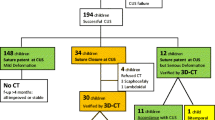Abstract
Background
Craniosynostoses are the most frequent craniofacial malformations. Diagnosis has for long time relied on standard radiographs, and still nowadays, they are of first step in the evaluation of suspected craniosynostosis. CT and MRI scans are also valuable tools for further diagnostics in craniosynostoses, but they expose the children to a large amount of radiation or they require sedation due to scarce patient compliance. The value of ultrasound as a screening tool for craniosynostosis remains non-established, but it offers a non-expensive, non-risky, and fast mean of detection for sutural growth impairment. The aim of this study is to demonstrate the effectiveness of the use of ultrasound as a diagnostic and follow-up tool in newborn children affected by craniostenoses.
Methods
We have selected 17 children, whose clinical findings were clinically suggestive for craniostenosis or head molding. All patients underwent an ultrasound examination, and those positive for craniostenosis or with an uncertain diagnosis also underwent CT scan examination. All patients positive for craniosynostosis and patients in which diagnosis was still unsure also underwent a CT scan examination for further confirmations; results from CT scan were then compared to those obtained with ultrasound examinations.
Results
Five infants had normal appearance of the cranial sutures on US. In 12/17 infants, US identified premature closure of one or more cranial sutures in particular. Results from CT scan compared to those obtained with US examinations showed a 100 % match between the two techniques.
Conclusions
In our experience, ultrasound examination has shown to be an effective, fast, inexpensive, and non-risky method for diagnosis and assessments in children with craniostenoses and was able to detect the presence of synostosis in all patients affected with a 100 % match with CT scan examination.
Level of Evidence: Level III, diagnostic study.






Similar content being viewed by others
References
Simanovsky N, Hiller N, Koplewitz B, Rozovsky K (2009) Effectiveness of ultrasonographic evaluation of the cranial sutures in children with suspected craniosynostosis. Eur Radiol 19(3):687–692, Epub 2008 Oct 22
Richtsmeier JT, Grausz HM, Morris GR, Marsh JL, Vannier MW (1991) Growth of the cranial base in craniosynostosis. Cleft Palate Craniofac J 28(1):55–67, 109
Frassanito P, Di Rocco C (2011) Depicting cranial sutures: a travel into the history. Childs Nerv Syst 27(8):1181–1183
Cerovac S, Neil-Dwyer JG, Rich P, Jones BM, Hayward RD (2002) Are routine preoperative CT scans necessary in the management of single suture craniosynostosis? Br J Neurosurg 16(4):348–354
Agrawal D, Steinbok P, Cochrane DD (2006) Diagnosis of isolated sagittal synostosis: are radiographic studies necessary? Childs Nerv Syst 22(4):375–378, Epub 2005 Sep 27
Massimi L, Caldarelli M, Tamburrini G, Paternoster G, Di Rocco C (2012) Isolated sagittal craniosynostosis: definition, classification, and surgical indications. Childs Nerv Syst 28(9):1311–1317, Epub 2012 Aug 8
Kotrikova B, Krempien R, Freier K, Mühling J (2007) Diagnostic imaging in the management of craniosynostoses. Eur Radiol 17(8):1968–1978, Epub 2006 Dec 7
Kirmi O, Lo SJ, Johnson D, Anslow P (2009) Craniosynostosis: a radiological and surgical perspective. Semin Ultrasound CT MR 30(6):492–512, Review
Medina LS, Richardson RR, Crone K (2002) Children with suspected craniosynostosis: a cost-effectiveness analysis of diagnostic strategies. AJR Am J Roentgenol 179(1):215–221
Mitchell LA, Kitley CA, Armitage TL, Krasnokutsky MV, Rooks VJ (2011) Normal sagittal and coronal suture widths by using CT imaging. AJNR Am J Neuroradiol 32(10):1801–1805, Epub 2011 Sep 15
Branson HM, Shroff MM (2011) Craniosynostosis and 3-dimensional computed tomography. Semin Ultrasound CT MR 32(6):569–577
Pelo S, Tamburrini G, Marianetti TM, Saponaro G, Moro A, Gasparini G, Di Rocco C (2011) Correlations between the abnormal development of the skull base and facial skeleton growth in anterior synostotic plagiocephaly: the predictive value of a classification based on CT scan examination. Childs Nerv Syst 27(9):1431–1443, Epub 2011 Jul 1
Sze RW, Parisi MT, Sidhu M, Paladin AM, Ngo AV, Seidel KD, Weinberger E, Ellenbogen RG, Gruss JS, Cunningham ML (2003) Ultrasound screening of the lambdoid suture in the child with posterior plagiocephaly. Pediatr Radiol 33(9):630–636, Epub 2003 Jul 18
Regelsberger J, Delling G, Helmke K, Tsokos M, Kammler G, Kränzlein H, Westphal M (2006) Ultrasound in the diagnosis of craniosynostosis. J Craniofac Surg 17(4):623–5, discussion 626–8
Soboleski D, Mussari B, McCloskey D, Sauerbrei E, Espinosa F, Fletcher A (1998) High-resolution sonography of the abnormal cranial suture. Pediatr Radiol 28(2):79–82
Conflict of interest
None
Patient consent:
Children's parents provided written consent for the use of their images.
Author information
Authors and Affiliations
Corresponding author
Rights and permissions
About this article
Cite this article
Saponaro, G., Bernardo, S., Di Curzio, P. et al. Cranial sutures ultrasonography as a valid diagnostic tool in isolated craniosynostoses: a pilot study. Eur J Plast Surg 37, 77–84 (2014). https://doi.org/10.1007/s00238-013-0898-0
Received:
Accepted:
Published:
Issue Date:
DOI: https://doi.org/10.1007/s00238-013-0898-0




